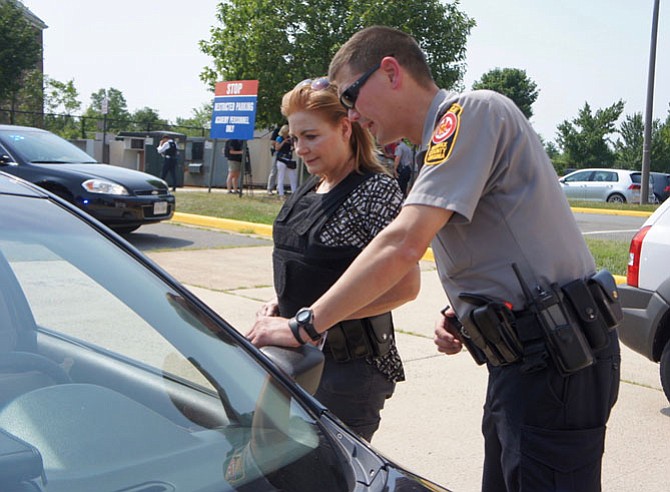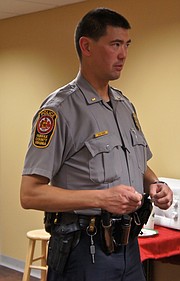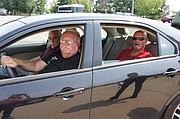Kathy Stewart from News Radio WTOP gets some pointers from 2nd Lt. Dan Pang in how to conduct a traffic stop. Photo by Andrea Worker.
Think you know what you would do if you were dispatched to handle a domestic dispute? Or if you were handling a “routine” traffic violation and the driver, sitting behind darkly-tinted windows wouldn’t obey your instructions? Or you were called to the scene of a horrific accident where lives have been lost? With the exception of those who officially work these situations, members of the press probably get a closer look at these events than the average citizen, but a group of area media personnel were put to the test by several Fairfax County’s police officers who gave them a glimpse of life behind the badge at the inaugural Fairfax County Police Department (FCPD) Media Police Academy.
“It’s our first-ever academy for the media,” said Julie Parker, FCPD Media Relations director, who came to her position from a background in journalism. The department currently runs a Citizens’ Academy and a Teen version, but as Parker said, it’s the media that “cover us … we felt that there isn’t enough education … for reporters covering very serious topics.” Parker also said that the FCPD was looking for feedback from the media.
THE BRAINCHILD of 2nd Lt. Dan Pang, who served as co-host, instructor, mentor and supervisor of the media rookies, the July 20 all-day session was held at the Fairfax County Criminal Justice Academy in Chantilly — the same facility where police recruits start their training in hopes of passing muster and eventually hitting the streets to “serve and protect.”
Making it into those ranks in Fairfax County requires eight hours of psychological testing, extensive background checks, and six months of Academy training comprising lectures, practicals and skills training in defense, driving and firearms training. “You have to get each skill right, respond appropriately in each scenario,” said Pang. There’s coaching and counselling to correct mistakes, but the newbies are subject to a “three strikes and you’re out” rule.
If the recruits make it that far, they move on to 90 days in the real world, with a field officer partner. Pass that test, and the recruit is now a rookie and it’s time to do the job solo, or as a partner.
Pang took his “students” into the emotional life of a police officer. “It’s a roller coaster,” he said. “You try to turn it off and on, but it’s not always so easy to do. We are in a constant state of elevated alertness. Failure to do so could kill us.”
Pang used the terms “hypervigilance” and “stimulus habituation” and referenced the book “Emotional Survival for Law Enforcement, A Guide for Officers and their Families,” by Kevin Gilmartin, Ph.D. to describe what life is like for himself and his fellow officers.
According to Gilmartin and other research, when law enforcement personnel get home, they may actually experience a “chemical dump” of the adrenaline and other chemicals that have kept them in this state. It can be such an overpowering relief to the brain and body that the officer almost literally shuts down. Pang and several of his colleagues who participated in the session spoke about times when they have come home and “just hit the couch and went out like a light.”
There are other effects on a police officer’s personal life that have been noted. “Cops tend to like toys,” said Pang. Things like boats, ATVs and electronic gadgets “can compensate for the high when you’re not on duty. Cops can become impulse buyers.” He acknowledged that it’s a trait that is not always conducive to a harmonious family life.
There are also societal effects resulting from a police officer’s daily lifestyle. Alienation from friends and family can occur as some law enforcement personnel feel only their fellow officers can really relate to them. Amp that feeling up over time and that alienation can cause some officers to see everyone around them as untrustworthy.
With all that they see and that they do, and with the personal toll that their work can take on them, it’s probably no wonder that 85 percent of law enforcement personnel have experienced some kind of negative mental health symptoms. Almost 84 percent have been witness to, or involved in a traumatic event. More than 20 percent have suffered from some level of Post Traumatic Stress Syndrome and 27 percent have admitted to depression. The suicide rate for those working in law enforcement is three times the rate of the general population.
A veteran officer agreed to share a personal story with the attendees, having been involved in more than one fatal shooting encounter during [his/her] career. The condition for opening up in this way was a request for anonymity. No recording. No note-taking. “As you can perhaps understand,” said the officer, “these were difficult situations and experiences – for me, my family and for the families of the victims.” The officer did not wish to bring new attention to these events and cause additional pain or concern for anyone involved.
Both events were ultimately declared as justified uses of force, and, in fact, in one case the officer’s actions saved further loss of life or injury to other officers and members of the public. But the scrutiny, the investigations, the sudden removal from the job and the familiar surroundings and support from fellow officers, as well as the fear of retaliation against the officer or family members, made for “the most difficult time of my life” — and through it all you have to deal with the gravity of your own actions.
TO ILLUSTRATE HOW QUICKLY a situation can turn deadly — regardless of training or preparedness — the class reviewed some bodycam videos that also highlighted the “power of perspective.” Watching real-life scenes of traffic stops and one of an eviction from different angles and sources, and in one case, with and without sound, gave everyone pause for thought. Viewed from just one perspective, or in silence, judgments were quickly made as to who was responsible for the violent outcomes. As more sources were layered in, or sound introduced, that certainty quickly faded, or positions even reversed.
“I think you get the point,” said Pang.
Kathy Stewart, an attendee from WTOP, agreed, saying the video exercise just emphasized the importance of “getting the whole story” and of the power that lies in the hands of those reporting.
Next on the agenda was strapping on 30-plus pounds of gear (holster, “gun,” handcuffs, etc.) to perform some “traffic stops” in the back parking lot, after some tips on where to stop a vehicle, how to approach it, what to look for, how to address the driver and other occupants, and how to stay as safe as possible.
PFC Mark Pollard of the Motor Squad, who helped run the exercise, was an approachable and thorough instructor, but hadn’t much sympathy for complaints about heat. “We’re out here, no matter what. Sun, snow, rain. That’s our job.”
“Driver” Fred Sanborn of Springfield has attended the Citizens Police Academy and seemed to relish his role as one of the difficult citizens being stopped. Waving-off the “officers” who approached, Sanborn just kept on with his cell phone conversation and then argued every step of the way.
Pollard was pretty matter-of-fact when some of his media students looked back in hesitation at Sanborn’s failure to cooperate. “Deal with it if they don’t listen to you,” was his response. “Stay polite,” he added, “and use your ‘command control’ voice.”
The debrief from this exercise showed that in their anxiety to do things right and not miss a step, everyone overlooked something potentially deadly — like a knife on the dashboard, or a small handgun hidden alongside a driver.
OTHER HANDS-ON EXERCISES had the faux-recruits responding to a call of a domestic dispute, or being dispatched to calm an increasingly violent individual. “These are very much every-day occurrences,” said Pang, “and the often the most dangerous.”
Even in these controlled circumstances, with cameras recording and at least a few of their peers silently watching, many of the participants admitted that the situations still had a physical effect.
David Culver, an anchor and reporter with Washington’s NBC News 4, was one of the media students who successfully diffused an escalating situation without injury or worse, but when he felt forced to draw his “weapon” to control the “suspect” he said that during the “encounter” he still felt his heart racing.
In between stepping in and out of the role of law enforcers, there were portions of the program designed specifically for those in attendance. Police Chief Ed Roessler joined the group for a working lunch and answered questions about increasing efforts to infuse the department with transparency, the recent formation of the Citizen’s Police Review Board, the effect of social media on policing, and other issues.
Transparency and an additional outlet for citizens to turn to are the right way forward, according to Roessler, who acknowledged that the changes are difficult for many. “There is a certain level of fear and anxiety among the troops,” he said. So many recent deadly incidents that have occurred in police departments around the country are not only tragic for the victims, but they add another level of stress and difficulty for the officers who are just trying to do the right thing and protect, even to the extent of putting their own lives on the line.
Despite the obstacles, Roessler remains committed to supporting changes in training, departmental policies and furthering community engagement. The chief pointed to the department’s strong relationship with the All Dulles Area Muslim Society (ADAMS) Center that straddles the line between Fairfax and Loudoun counties.
“That’s a relationship that both parties have been building since the ’90s” and has served the community well many times since then, most recently during the investigation into the murder of 17-year-old Nabra Hassanen of Reston, who was a member of the mosque. While many were immediately categorizing Hassanen’s death as a hate crime, even in the midst of their shock and grief, ADAMS Center released a statement thanking FCPD and the Loudoun County Sheriff’s department for their “diligent efforts in investigating and apprehending a suspect.”
Major Christian Quinn, Commander Division III, Patrol Bureau and Assistant Commonwealth’s Attorney Casey Lingan, joined Parker in a further Q&A session. The timing and the amount of information being released to reporters was the predominant issue.
Human nature may make some hesitant to speak to media outlets. “No one likes to be humiliated. There is definitely a growing sense that people are looking for that ‘gotcha’ moment,” said Quinn.
Parker said that the Media Relations Bureau was dedicated to making accurate information available as quickly as possible. All three gave examples where information had to be held for legal reasons, or should be held to protect the investigation or the rights of those involved.
ABC7 newsman Sam Sweeney questioned circumstances where reporters are “pushed back from a scene” while neighbourhood residents were allowed to move more freely around the area. The trainers answered that there could be legitimate reasons for holding back reporters and others — particularly in scenes where the presence of more people might make it even more difficult for the police to keep an eye on all activities — but Parker reminded that the police information officer on scene is available. “And if you think you are having a problem, you can always call our office. We will do our best to get you information and access.”
Media Police Academy ended with a “Shoot-Don’t Shoot” simulation. In the controlled exercise, Peggy Fox with WUSA9 and John Aaron with WTOP “saved the day” even though in the stress of the situation, they failed to notice innocent bystanders walking in the background. “It’s a real eye-opening experience,” said Aaron.
The Police Department plans to make the Media Police Academy an annual event to keep the dialogue open between law enforcement and the people who bring their stories to the public.
Citizens interested in getting a more in-depth look at policing in the community may consider applying for the Citizens Police Academy at www.CPA@fairfaxcounty.gov. The department also has a Facebook page with information about current police actions and tips for safety.




